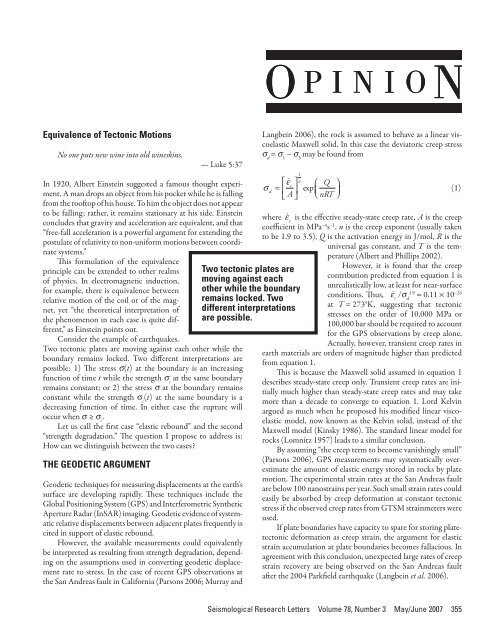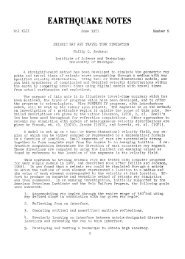OPINION OPINION - Seismological Research Letters
OPINION OPINION - Seismological Research Letters
OPINION OPINION - Seismological Research Letters
- No tags were found...
You also want an ePaper? Increase the reach of your titles
YUMPU automatically turns print PDFs into web optimized ePapers that Google loves.
WEATHER AND CLIMATE: AN APPARENTDIGRESSIONIt is often stated that the model of elastic rebound has been confirmedby plate tectonics. This “confirmation” exists in a globalkinematic framework; the process itself remains nebulous.Science is a system for understanding the world. The morea scientific theory generates new predictions, the more it isvalued, provided that the predictions can be quickly and easilyconfirmed or refuted. The proponents of elastic rebound(including Harry F. Reid and Andrew Lawson) expected positiveresults in earthquake prediction to provide a relevant testof the new model within a short period of time. This expectationwas disappointed or repeatedly postponed. A century later,earthquake prediction is notoriously lagging in confirmation.There has been no concerted effort to discover a substitute nullhypothesis against which elastic rebound could be tested.The weather-climate distinction is a basic feature of moderngeophysical predictions (Lorenz 1975).Climate is primarily a function of space (e.g.,latitude) while weather is mainly a functionof time (e.g., seasonal fluctuations). Inother words, climate is the response of thesystem to changes in the boundary conditionswhen the initial conditions are keptconstant, while weather is the time-dependentresponse of the system to changes inthe initial conditions when the boundaryconditions are kept constant (Hasselmann2002).Large-scale climate fluctuations such as El Niño, or largescaleweather variations such as winter storms or thunderstorms,are not known to occur in tectonics as they are in meteorology.This may be due to different time scales. Fluctuations inthe atmosphere are exogenous, primarily of solar origin, whilethose of earthquakes are endogenous. However, this distinctiondoes not necessarily exclude climate and weather effects in platetectonics.For example, there are systematic differences in the ratesof plate convergence or divergence at different boundariesthat cause the seismicity (or seismic climate) of East Asia tobe significantly more active than that along the Eastern Pacificboundary. Tectonic weather effects may be present as earthquakeswarms, earthquake triggering, or fluctuations in seismicitycaused by local depletion of seismic moment or temporaryquiescence (“seismic gaps”).Thus stress accumulation might plausibly be likened to aneffect of “earthquake weather.” Thunderstorms are caused by aspecific set of weather conditions. The atmosphere is unstablewith respect to small perturbations of the initial conditions.This affects predictability: A natural limit of up to 20 days isrecognized for purposes of weather prediction (Hasselmann2002). But weather conditions include a wide range of fluctuations,and predictability is understood not to apply to the finestructure of the phenomenon. In other words, the predictionof a thunderstorm does not extend to predicting the time andlocation of individual thunderbolts. Lightning is defined as acollective phenomenon, and it makes no sense to identify thelargest thunderbolt (the “main bolt”) and the following ones(“afterbolts”). In other words, the fine structure of the processis assumed to be random. Clearly, the analogy with tectonicsraises a whole set of new questions.The model of elastic rebound (Reid 1911) is based on fivepropositions:1.2.3.4.5.Lightning is defined as acollective phenomenon,and it makes no senseto identify the largestthunderbolt (the “mainbolt”) and the followingones (“afterbolts”).Fracture is caused by elastic strains exceeding the strengthof the rock.These strains accumulate over a long period of time.Coseismic motion represents the elastic rebound or releaseof the stored elastic strain.Seismic waves originate at the fracture of the rock.The energy of the earthquake equals the elastic strainenergy previously stored in the rock.These propositions are currently “accepted with only minormodifications” (National <strong>Research</strong> Council 2003), which isremarkable if one considers the age of themodel and the fact that nothing is statedabout the origin of strain accumulation. Inthe atmosphere or in the oceans, no analogousmodel has been proposed.What do we know about the dynamicsof tectonic processes? At present it isrecognized that “earth system processesperform work by degrading sources offree energy, thereby producing entropy”(Kleidon and Lorenz 2005). For example,the work required to drive atmospheric circulation is performedby degrading the temperature difference between theequator and the poles. There is no accumulation of temperaturedifferences anywhere. In elastic rebound, on the other hand,strain energy must accumulate in a bounded region of space.This idea runs counter to cosmic evolution (Chaisson 2005).Converting entropy into free energy is against the Second Lawof Thermodynamics. How can long-term local and regionalaccumulation of energy arise in an open steady-state system?Convection often is invoked at this point. But no energy accumulatesanywhere in a convecting system. Convecting systemsmay be observed in nature, e.g., in lava lakes that are generated inthe craters of volcanoes. Lava plates form at the surface throughcooling and are recirculated or shored up against the edges ofthe crater. But there is no local energy accumulation.Another puzzling feature of the model is the presence ofpre-existing faults. Earthquakes never occur in the undamagedhost rock. Fault zones are lithospheric features where the rock isdamaged as a result of environmental corrosion, usually becauseof the slow chemical action of water. Faults have a much lowerstrength than the surrounding rock; therefore fracture occurs ata much lower stress, and the amount of heat produced by frictionis much smaller than expected. This fact has been perceivedas a paradox (Rice and Cocco 2007; National <strong>Research</strong> Council2003, 53–54).The phenomenon of environmental stress fracture (Fontana1986) is caused by decaying shear strength at weaknesses in the356 <strong>Seismological</strong> <strong>Research</strong> <strong>Letters</strong> Volume 78, Number 3 May/June 2007
material under conditions of constant stress. It has been widelystudied in metals and other engineering materials. Often thereis no warning signal of an impending rupture, because there isno stress accumulation. But environmental stress fracture wasunknown in 1911.A steady-state system is defined as a system in which allstate variables have stationary means. Steady state is not thesame as equilibrium; for example, there must be a flow throughthe system. In steady-state convection there may be stress perturbations(an earthquake is such a perturbation), causing thesystem to generate transient responseflows that oppose and eventually cancelthe perturbation. The classic example of asteady-state system is a bathtub filling at aconstant rate. When the plug is pulled thewater will reach a stationary level definedby the inflow equaling the outflow.In general, complex systems far fromequilibrium, which lack fixed boundaryconditions, tend to drift toward a steadystate in which the entropy production ismaximized (Kleidon and Lorenz 2005).In a convection cell the external constraints include the temperaturegradient across the cell, but there is an energy balancein the system. The perturbations are short-lived and do notaccumulate.EVIDENCE FOR ELASTIC REBOUND VERSUSSTRENGTH DEGRADATIONA large-scale prediction experiment (1985–2004) was approvedand conducted on the San Andreas fault to test prevailing ideason earthquake processes. Using as input the time series of pastearthquakes at Parkfield, California, an event of magnitude 6was predicted to occur around 1988 plus or minus five years.Arrays of sensitive instruments were placed around the prospectiveepicenter to detect the expected precursory phenomenacaused by strain accumulation.The predicted earthquake did finally occur in 2004, but itwas the wrong earthquake! It was the right magnitude and itoccurred near the predicted location, yet it differed in significantdetails from the earthquake that had been expected. Therewas no evidence of any long-term or short-term precursory signals.Borehole strain meters recorded no strain accumulation. Itlooked as if the earth had not known an earthquake was imminent.Thus it was concluded that the expected “confirmation”by plate tectonics had failed. Many scientists felt that this wasnegative evidence, which proved nothing. Some proposed thatthe results be shelved or used to design a better experimentelsewhere. Yet the Parkfield experiment remains the only fullscaletest of elastic rebound. It had been carefully designed, andadvanced equipment and instrumentation had been used.Alternate models, such as the model of strength degradation,were not tested. However, the field data of the Parkfieldexperiment fit strength degradation better than elastic rebound.The Parkfield experimentwas located at the boundarybetween two such inertialframes of reference. Doesthis mean that we cannotdetermine which of thesetwo mechanisms appliedin the case of the 2004earthquake?In terms of internal consistency, the striking absence of precursorysignals agreed with the lack of success in earthquake prediction.Observations from borehole strain meters also suggestthat the effect of transient creep had been seriously underestimated.EQUIVALENCE ≠ UNCERTAINTYThe question we set out to answer, about the equivalencebetween elastic rebound and strength degradation, might nowbe settled in the affirmative at this point.But are they equivalent in the Einsteiniansense?Einstein stated that two processes areequivalent when the outcome of a physicalexperiment in a laboratory that movesin an inertial frame of reference is thesame independent of the location and thevelocity of the laboratory in space-time.The Parkfield experiment was located atthe boundary between two such inertialframes of reference. Does this mean thatwe cannot determine which of these two mechanisms appliedin the case of the 2004 earthquake? Not at all.Equivalence is not the same as uncertainty. The equivalenceprinciple does not imply that an observer in free fall cannotdetect or measure the gravitational field. To use the examplesproposed by Einstein himself, equivalence will not prevent anexperimenter from deciding whether to move the coil or themagnet in an induction experiment. The outcome may be thesame in either case, but extraordinary precautions must be takenif the observer is to remain ignorant of what he is observing.As for the man who falls from the roof, someone might havewarned him—before jumping—that he was in a gravity field.The Parkfield experiment demonstrates unequivocally thatthere is no detectable strain buildup at plate boundaries beforean earthquake. Yet the evidence is not accepted as conclusive,because of the widely accepted interpretation of geodeticobservations as “proving” that tectonic stresses are accumulatingat the San Andreas fault. The question is: did the Parkfieldexperiment achieve what it set out to test? If so, a discussionon alternative models of earthquake causation is mandatory. Ifnot, where and how should the hypothesis of elastic reboundbe tested?In the meantime, elastic rebound should be put on hold, asbeing due for a fundamental revision.REFERENCESAlbert, R. A., and R. J. Phillips (2002). Time-dependent effects in elastoviscoplasticmodels of loaded lithosphere. Geophysical JournalInternational 151, 612–621.Chaisson, E. J. (2005). Non-equilibrium thermodynamics in an energy-richuniverse. In Non-equilibrium Thermodynamics and the Production ofEntropy: Life, Earth, and Beyond, ed. A. Kleidon and R. D. Lorenz,21–31, Berlin and New York: Springer.Einstein, A. (1920). Fundamental ideas and methods of relativity (unpublished).Quoted in G. Holton, Einstein’s third paradise, Daedalus<strong>Seismological</strong> <strong>Research</strong> <strong>Letters</strong> Volume 78, Number 3 May/June 2007 357
(Fall 2002), 26–34, http://www.aip.org/history/einstein/essay-einsteins-third-paradise.htm.Fontana, M. G. (1986). Corrosion Engineering. New York: McGraw-Hill.Hasselmann, K. (2002). Is climate predictable? In The Science of Disasters:Climate Disruptions, Heart Attacks, and Market Crashes, eds. A.Bunde, J. Kropp, and H.-J. Schellnhuber, chapter 4, 141–169. Berlinand New York: Springer.Kinsky, R. (1986). Engineering Mechanics and Strength of Materials.Sydney, Australia: McGraw-Hill.Kleidon, A., and R. Lorenz (2005). Entropy production by earth systemprocesses. In Non-equilibrium Thermodynamics and the Production ofEntropy: Life, Earth, and Beyond, eds. A. Kleidon and R. D. Lorenz,1–20, Berlin and New York: Springer.Langbein, J., J. R. Murray, and H. A. Snyder (2006). Coseismic and initialpostseismic deformation from the 2004 Parkfield, California,earthquake, observed by Global Positioning System, electronic distancemeter, creepmeters, and borehole strainmeters. Bulletin of the<strong>Seismological</strong> Society of America 96 S304–S320.Lomnitz, C. (1957). Linear dissipation in solids. Journal of Applied Physics28, 201–205.Lomnitz, C. (2007). The Parkfield prediction experiment: Scientific alternativesto elastic rebound (submitted to Bulletin of the <strong>Seismological</strong>Society of America).Lorenz, E. N. (1975). Climate predictability: The physical basis of climateand climate modeling. Global Atmosphere Prediction Programme,WMO, Report 16, Geneva.Murray, J., and J. Langbein (2006). Slip on the San Andreas fault atParkfield, California, over two earthquake cycles, and the implicationsfor seismic hazards. Bulletin of the <strong>Seismological</strong> Society ofAmerica 96, S283–S303.National <strong>Research</strong> Council (2003). Living on an Active Earth: Perspectiveson Earthquake Science. Washington, DC: National AcademiesPress.Parsons, T. (2006). Tectonic stressing in California modeled fromGPS observations. Journal of Geophysical <strong>Research</strong> 111, B03407,doi:10.1029/2005JB003946.Reid, H. F. (1911). The elastic-rebound theory of earthquakes. Universityof California Department of Geology Bulletin 6 (19), 413–444.Rice, J. R., and M. Cocco (2007). Seismic fault rheology and earthquakedynamics. In Tectonic Faults: Agents of Change on a Dynamic Earth[report of the 95th Dahlem workshop on the dynamics of faultzones, Berlin, January 16–21, 2005], ed. M. R. Handy, G. Hirth, andN. Hovius, chapter 5. Cambridge, MA: MIT Press.Cinna Lomnitzcinna@prodigy.net.mx358 <strong>Seismological</strong> <strong>Research</strong> <strong>Letters</strong> Volume 78, Number 3 May/June 2007
















